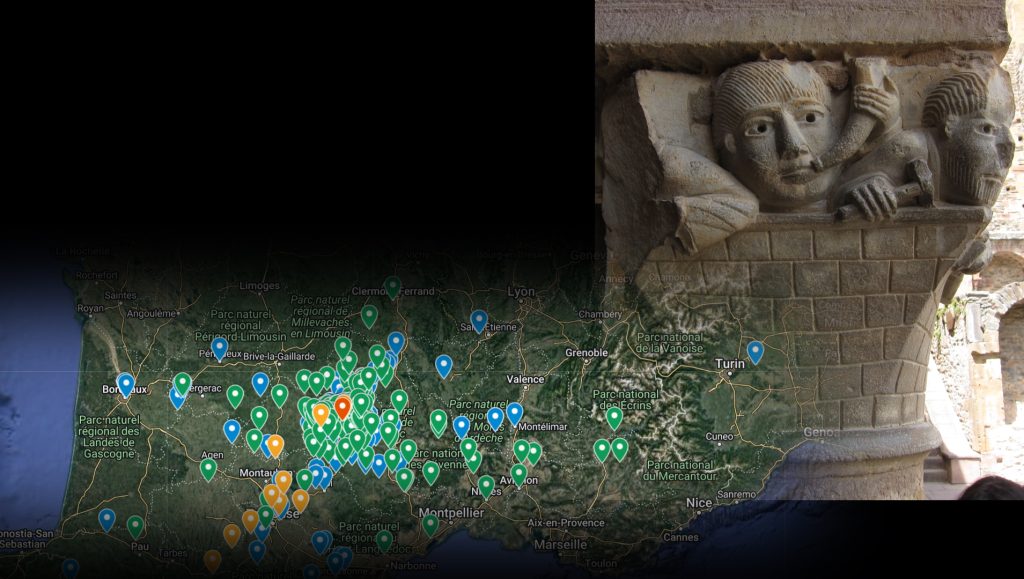by Jasmin Richardson (3rd Year BA History) Tomas Shannon (Ma in Medieval Studies)
‘Mapping Monasticism: the Abbey of Conques and its Network’ is an undergraduate research project supervised by Dr Michele Luigi Vescovi which involved recording and mapping medieval donations to the abbey of Conques – this project was developed in the framework of the School of History and Heritage Undergraduate Research Opportunity last academic year. We mapped the medieval donations to Conques from records within the Cartulaire de L’Abbaye de Conques en Rouerge, edited by Gustave Desjardins (1879). This French book is essentially a cartulary, a collection of medieval documents, containing all of the property and land that was owned and controlled by the Abbey. The first phase of the project required us to read through the cartulary recording all churches, land and hospitals donated to the abbey on a spreadsheet, for a total of ca. 350 entries. We also recorded additional details pertaining to the donation, such as the donor’s name, the distance from Conques (in days of travel), and additional notes (i.e. date of donation), and we divided these entries based on the ‘type’ of donation (churches, lands, hospitals, etc). Once this phase had been completed, we moved onto mapping the donations. This involved locating and mapping each of the entries onto a colour-coded Google Maps with notes on the brief details recorded in the spreadsheet.

The project, while rewarding, was not without its challenges. First and foremost, the Cartulary is recorded in French and neither of us are fluent, this was further complicated by the use of phrases which no longer appear in modern French and therefore couldn’t be easily identified and understood. However, through research and persistence, repeated phrases became more easily recognisable, speeding up the work. Another problem we faced was deciding how to record each donation’s distance from the Abbey. Initially we agreed to record the walking distance from the mother abbey in days of travel as suggested by Google Maps. However, it soon became clear that this would not be an effective and realistic measurement as an individual would have not walked continuously for 24 hours each day. Our research needed to account for rest. We settled on recording any distance under 6 hours as being in the ‘immediate vicinity’ of Conques with 0 days of travel, anything from 6-12 hours of travel as 1 day, 12-24 as 2 days and so on, so forth. While this method gives a more realistic representation of travel time to and from the mother abbey, we must consider that the travel time is calculated using modern roads and does not necessarily consider the terrain, its orography and other challenges faced during the journey. However, the data still gives us an interesting perspective towards analysing geographical trends in donations. The final difficulty we faced arose at the mapping stage. Some of the locations mentioned in the cartulary don’t exist anymore, or at least they don’t appear on Google Maps, therefore we had to rely on clues within the text and work logically based on the donations surrounding the entry, as often these issues could be resolved by altering the spelling of certain locations to find the new name as recorded on Google Maps.
From our research, we concluded that there was a rich network of holdings associated with Conques in the Middle Ages, not only limited to France but including properties and lands in England, Spain and Italy. Furthermore, the scope of these donations highlights the importance of Conques as a religious, economic and social centre in the Middle Ages. The project has been a really exciting opportunity to develop new research skills and methodologies and we are both grateful to have played a small role in such an exciting project. The map was presented by Dr Michele Luigi Vescovi in his talk ‘Conques: Monastic Network, Artistic Practices’ at the conference ‘From Global to Local: Conques as a Crossroads (9th-13th c.)’, in New York (Hunter College, CUNY, July 2022).
For more information on the Conques in the Global World project, visit this link and to access our digital map of the donations to Conques, click here.
